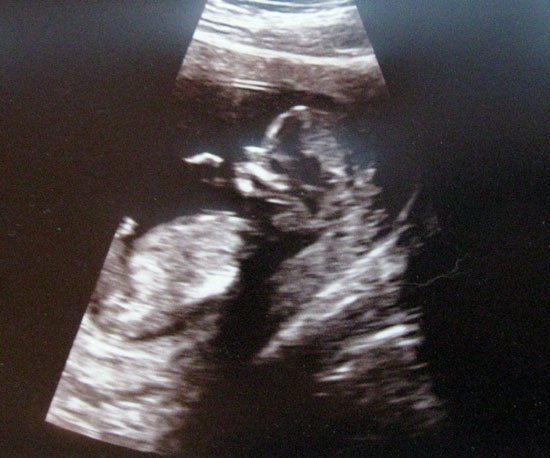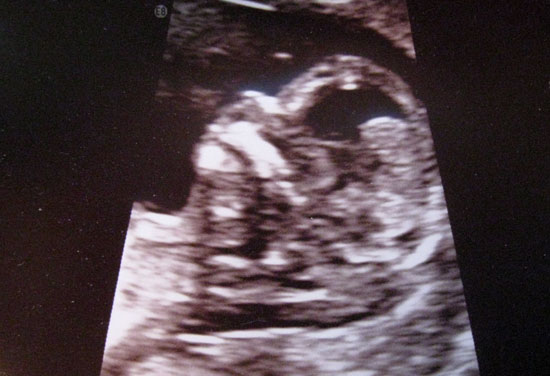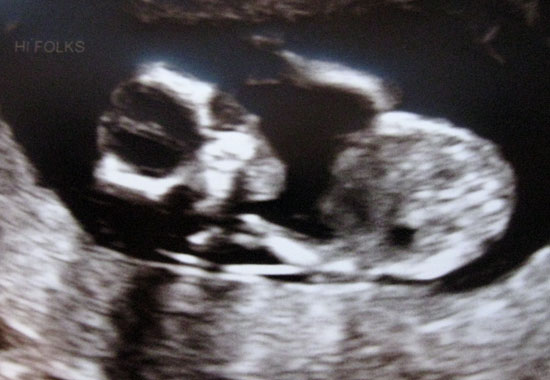My husband, The Gryphon, and I had trouble finding the
prenatal center at the hospital where the sequential screening took
place. It was a different hospital than the one where my ob-gyn practices,
though it's in the same hospital system. We wondered in about 15 minutes
late, and I raced to fill out all the required forms.
At first, everything about the ultrasound seemed good.
We were thrilled that our progeny now looked recognizably human (albeit
only about two and a half inches long at that point). The baby was active,
waving its developed arms around (yay! the arm buds have grown into
arms). As the technician poked my stomach with the wand to try to get
the baby to reposition itself, the baby rolled over and did little floppy
movements on its back, like a budding breakdancer.
The heart rate was good, the technician informed us, and
the size was good for that stage in the pregnancy (about 12 weeks).
But then she measured the fluid at the back of the neck (nuchal
translucency) and noted it was a bit bigger than they like to see.
She called in the doctor to confirm this and speak to us further.
The doctor took another measurement, which confirmed the
result. He told us that it was in a higher range than normal, indicating
an increased risk of Down syndrome. Since the ultrasound results already
showed a possible problem, he said it wasn't necessary to do the blood
test. Instead, he recommended we consider further testing: either chorionic
villi sampling (CVS) or amniocentesis.
"I know this isn't the result you were hoping for,"
he said, "but I don't want you to walk away from this thinking
that your baby has Down syndrome. All this test shows is that there
is an increased risk." He recommended the CVS because it could
be done sooner (between 10-12 weeks, compared to 15 or 16 weeks for
amniocentesis). He told us to take some time to think about it and then
call back to schedule if we wanted to do the CVS. A slot was available
that afternoon, but that was out of the question, because The Gryphon
had to get back to work.
I believe this doctor has given this sort of news fairly
frequently. The tone of his voice was very rehearsed, almost bored.
Either that or he just wanted to go to lunch (which he did as soon as
we left). I'm not saying he wasn't helpful or that he didn't say the
right things; it's just that he lacked a certain warmth that might have
helped cushion the blow.
The walk out of the hospital was difficult, as I tried
to hold in my worried tears. I managed until we got into the car, then
broke down. The Gryphon soothed me and told me that there was no reason
to be so upset at this point. After lunch and a phone conversation with
my dad, an osteopath, we agreed to sign up for the CVS.
After dropping The Gryphon at work, I sat in the parking
lot and called the perinatal center again to schedule the procedure.
It was the Tuesday before Thanksgiving, and staffing was light, but
after I waited on hold for a while, the receptionist was able to schedule
the procedure for the Monday after Thanksgiving. I then called my ob-gyn's
office to give them the information and to share the fax number where
they had to fax my blood type and orders for the procedure.
Then came nearly a week of waiting. We didn't tell anyone
else in the family about the ultrasound results, only that we were waiting
for results from the genetic screening. I didn't want to worry them
with the ultrasound results until we knew more. I was actually a little
happy that I felt ill for part of the holiday, so that my mom wouldn't
guess the true cause of my seeming down.
For the CVS, we drove to yet another hospital, where we
again had some trouble finding the perinatal center. At least this time,
though, we arrived closer to our appointment. Again, I filled out some
forms, and then we waited for the genetic counselor to speak to us.
The genetic counselor spoke to us about our family histories
while she made up a family tree. After reviewing it, she said there
were no significant increased risks based on our heritage. She then
pointed to a couple charts in a spiral-bound book, showing us the risks
of having a baby with Down syndrome, based on my age as well as based
on the size of nuchal translucency (a similar chart based on age can
be found here).
Based on the nuchal transparency, which were the lower odds, there was
a 70 percent that our baby would be normal. Fairly good odds, but still
sobering.
She showed us an example of the sort of results doctors
would receive from the test. It would give them a full genetic picture
so that they could check for missing or additional chromosomes.
After a short wait, we were taken into another room for
the procedure, beginning with another ultrasound. In this one, the baby
was rolled on its side, facing us. The technician took a picture with
its hands on either side of its face, as if waving. In the corner, she
typed, "Hi Folks." Again, the heart rate and activity were
good.
The technician, RNs and doctor were all female and very
friendly, setting me at ease. They described exactly what would be happening,
both before and during the procedure. The easy, gentle way they interacted
with each other and me were soothing, helping me to be calm throughout
the process.
In my case, the placenta was situated in such a way that
the doctor could do the procedure through the cervix, rather than inserting
a needle into my stomach. For those who are interested in an illustration,
you can find one at the Mayo Clinic's site here.
It looks painful, but it was only a little uncomfortable.
I watched the procedure on a screen, which was somewhat
amazing. The baby's heart rate afterwards was the same, and they told
me that it probably didn't even know anything had happened. Perhaps
my calmness helped, as well.
Then, once more, it was a waiting game. The results, they
said, would be ready in 8 to 10 days, depending on how quickly the cells
cloned in the lab.
So this takes us back to today: me with the phone pressed
against my ear, waiting to hear the results. After confirming my personal
information, for privacy reasons, the caller told me it was good news.
Our baby has 46 chromosomes, the normal number: no extras and none missing.
I exhaled, enormously relieved. Even though I'd had a dream a couple
nights before that our baby was healthy, I hadn't been able to relax
until I knew it for sure.
Then, a surprise.
"Did you want to know what gender you're having?"
she asked.
"Yes," I told her.
"It's a boy."
While previously, I had hoped for a girl and imagined
I would be disappointed if we had a boy instead, my perspective has
entirely changed. This is what was running through my head this morning:
"Our baby has the right number of chromosomes! Hooray! Oh, and
it's a boy. Imagine that."
Considering that we've only chosen a girl's name so far,
I'm looking forward to flipping through my baby name books. As if in
sympathy, the rain that had held for days cleared up. The world was
suddenly bright once more.




